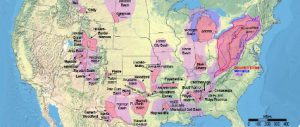On January 17, a gas well operating on state forest lands in Ward Township, a small settlement in America’s north-eastern state of Pennsylvania, experienced a blowout. The rupture sent an uncontrolled plume of drilling fluids and sand surging into the air, prompting the site’s operator, Canada-based Talisman Energy, to shut down all of its North American wells employing the same technology.
The Ward Township well was using a drilling method called hydraulic fracturing – more commonly known as “fracking” – which, largely thanks to its starring role in Oscar-nominated film Gasland, has shot onto the US public agenda. Now, concerns over its impact on water quality have prompted state and national environmental regulators to sit up and take notice. But can they move quickly enough?
Fracking involves drilling to depths of up to 2,300 metres, and then injecting a slurry comprising water, sand and a cocktail of chemicals into existing fissures in shale deposits at intense pressure. The sand props open the fractures and, when the slurry is pumped back to the surface, natural gas – freed from pores in the fractured rock – flows.
Depending on your point of view, Ward Township sits on either a geological gift or a curse. A glance at a map of the United States’ major shale-gas plays (areas targeted for exploration) will tell you why. The largest blot of colour is a bulbous mass, covering 246,000 square kilometres and extending into the states of Ohio, West Virginia, Pennsylvania and New York. It is the Marcellus Shale, thought to be the richest shale-gas play in the United States.
In 2008, two academics from Pennsylvania State University estimated that around 1.4 trillion cubic metres of recoverable natural gas could be extracted from the Marcellus Shale; by November that year, the estimate had rocketed to 10.3 trillion cubic metres – equivalent to roughly 15 years of US gas consumption.
Talisman mobilised: in 2010, the company invested US$1 billion (6.6 billion yuan) in the development of wells in the Pennsylvania section of the formation. This year, it plans to drill 100 more, with production topping out at 11.3 million cubic metres per day.
Fracking is not a new concept. In the mid-1970s, the US Department of Energy funded the first research into the advanced drilling technology that would make it possible. But progress stalled until two factors – the maturation of drilling techniques and surging gas prices – aligned at the end of the last decade. A boom was born.
In 2000, unconventional natural gas, much of it freed from shale deposits by hydraulic fracturing, accounted for 1% of gas production in the United States. In 2010, the figure was 10%. By 2035, the US Energy Information Administration (EIA) projects that shale gas will account for just over one quarter of US gas production.
But extracting natural gas from shale deposits thousands of metres underground poses significant environmental risks. Up to 19 million litres of water are necessary to fracture each horizontal shale-gas well, according to the US Environmental Protection Agency (EPA). The fracturing fluid – the slurry – is commonly 99% water but, because so much liquid is used, the final 1% can contain as much as 57,000 litres of chemicals per well. After withdrawal, up to 85% of the slurry remains underground.
In January last year, the Environmental Working Group (EWG), a Washington, DC-based NGO, released a report stating that oil and gas companies were injecting petroleum distillates, including kerosene, mineral spirits and other petroleum products that often contain high levels of known human carcinogen benzene, into hydraulic-fracturing wells. While US Congress exempted most types of fracking from regulation under the Safe Drinking Water Act in 2005, fracking with diesel fuel still requires a permit. Companies using petroleum distillates in their fracking fluid appeared, EWG argued, to be working around this.
The report also cited research indicating that fracking – now used in 90% of US natural gas wells – had been linked to drinking-water contamination and property damage in Colorado, Ohio, Pennsylvania, Wyoming and other states.
Findings detailed in a US congressional probe released on January 31 this year corroborate EWG’s suspicion that oil and gas firms have injected diesel fuel into fracking wells without a permit. In a letter to EPA administrator Lisa Jackson, lawmakers wrote that “between 2005 and 2009, oil and gas service companies injected 32.2 million gallons [121.9 million litres] of diesel fuel or hydraulic-fracturing fluids containing diesel fuel in wells in 19 states.”
Increasing public focus on fracking was inevitable: after all, the Marcellus Shale looms beneath two of the most populous US states, Pennsylvania and New York. But it was the portrayal of fracking in Gasland and an episode of CSI: Crime Scene Investigation, America’s top-rated television drama, that forced the issue into the national conversation.
Nothing did more to stir public consciousness than footage, in Gasland, of a Colorado landowner setting tap water aflame in his kitchen. The oil and gas industry responded fiercely to the implication that fracking was responsible for contaminating the water. A statement from America’s Natural Gas Alliance said that the flaming tap water was caused by naturally occurring methane and criticised the film’s “egregious” and “misleading” claims. But, for many, that fireball remains a potent symbol of the drilling technique’s dangers.
Now, regulators too are taking notice. In December last year, New York State issued a temporary fracking moratorium. The month before that, the city of Pittsburgh, Pennsylvania, adopted the nation’s first fracking ban. In September, new rules took effect in Wyoming, requiring that oil and gas companies disclose the chemicals used in their fracking fluid. Companies can petition for exemptions – the recipes of fracking fluids have long been considered trade secrets – but the Wyoming regulations are viewed as a potential national model. Indeed, the US Department of the Interior, manager of hundreds of millions of acres of federal land, is developing rules similar to the Wyoming regulations for wells on public land.
Calls for transparency are also coming from investors. In January, five investment groups filed resolutions with nine major oil and gas companies, including ExxonMobil and Chevron, urging them to disclose the risks of their fracking operations. “Investors are concerned that the industry is barrelling ahead with large-scale fracking without concrete plans to manage the risks,” explained Andrew Logan, director of the oil and gas industry programme for Ceres, a coalition of investor and environmental groups.
“Investors aren’t seeking to end the process of fracking. Instead, they want companies to demonstrate that fracking can be done in a sustainable manner.”
Watching the fracking debate play out in the United States are countries believed to be sitting on shale-gas resources of their own. Near Blackpool, a city in the northern United Kingdom, Cuadrilla Resources says it has struck on what it calls the “first true shale-gas find in Europe”. And Shell, ExxonMobil, and ConocoPhillips are all reportedly involved in early gas-shale trials elsewhere in Europe.
However, the real event looks set to be in China. According to the EIA, the country’s geology points to greater unconventional gas potential than Europe. By 2035, the EIA projects that this source will account for 56% of China’s domestic production. Every bit of it will be needed. ExxonMobil predicted in January that demand for natural gas for power generation will jump six-fold in China by 2030. Under a deal struck during president Barack Obama’s visit to China in 2009, the United States pledged to help China meet that demand by assisting efforts to assess and develop the country’s shale-gas resources.
Back in Pennsylvania, Talisman Energy re-activated its fracking wells within a week of the blowout. The company said it had modified the design of a component that failed at the Ward Township well and will apply lessons learned at all of its drilling sites. But the incident re-affirms a grim reality: regulators are struggling to catch up with a booming industry.
The EPA seems to have received the message. In March 2010, it initiated a study to assess the potential risks to drinking water posed by fracking. Citing the still unquantified risk of ground and surface-water contamination, a report released in January by the United Kingdom’s Tyndall Centre for Climate Change Research urges the British government to suspend shale-gas development until at least the end of 2012, when the EPA is expected to release its fracking review.
Much as financial regulators were caught out as capital poured into subprime mortgage derivatives, pushing global markets to the brink in 2008, environmental regulators in the United States have proved themselves unprepared for the repercussions of an unchecked fracking boom. Now we can only hope that they – and their counterparts in other nations with shale-gas resources – catch up quickly.
Justin Gerdes is a freelance journalist based in California.
Homepage image from Gasland

